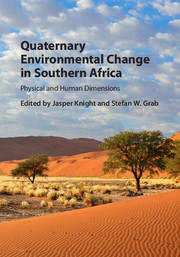Book contents
- Quaternary Environmental Change in Southern AfricaPhysical and Human Dimensions
- Quaternary Environmental Change in Southern Africa
- Copyright page
- Contents
- Contributors
- 1 The context of Quaternary environmental change in southern Africa
- 2 A brief geological history of southern Africa
- 3 A continental-scale perspective on landscape evolution in southern Africa during the Cenozoic
- 4 Hominin origins and evolution during the Neogene
- 5 Hominin evolution in Africa during the Quaternary
- 6 Quaternary environmental change on the southern African coastal plain
- 7 Dating the southern African landscape
- 8 Glacial and periglacial geomorphology
- 9 Colluvial deposits and slope instability
- 10 Desert dune environments
- 11 Changes in fluvial systems during the Quaternary
- 12 Wetlands in southern Africa
- 13 Sandy coasts
- 14 Environmental change during the Pleistocene and Holocene: Estuaries and lagoons of southern Africa
- 15 Soils and duricrusts
- 16 Karstic systems
- 17 Terrestrial ecosystem changes in the late Quaternary
- 18 Faunal evidence for mid- and late Quaternary environmental change in southern Africa
- 19 Pollen, charcoal and plant macrofossil evidence of Neogene and Quaternary environments in southern Africa
- 20 Minerogenic microfossil records of Quaternary environmental change in southern Africa
- 21 Development of the archaeological record in southern Africa during the Earlier Stone Age
- 22 Development of the archaeological record during the Middle Stone Age of South Africa
- 23 Later Stone Age hunter-gatherers and herders
- 24 Southernmost Africans, archaeology and the environment during the Holocene
- 25 Landscape–climate–human relations in the Quaternary of southern Africa
- Index
- References
20 - Minerogenic microfossil records of Quaternary environmental change in southern Africa
Published online by Cambridge University Press: 05 June 2016
- Quaternary Environmental Change in Southern AfricaPhysical and Human Dimensions
- Quaternary Environmental Change in Southern Africa
- Copyright page
- Contents
- Contributors
- 1 The context of Quaternary environmental change in southern Africa
- 2 A brief geological history of southern Africa
- 3 A continental-scale perspective on landscape evolution in southern Africa during the Cenozoic
- 4 Hominin origins and evolution during the Neogene
- 5 Hominin evolution in Africa during the Quaternary
- 6 Quaternary environmental change on the southern African coastal plain
- 7 Dating the southern African landscape
- 8 Glacial and periglacial geomorphology
- 9 Colluvial deposits and slope instability
- 10 Desert dune environments
- 11 Changes in fluvial systems during the Quaternary
- 12 Wetlands in southern Africa
- 13 Sandy coasts
- 14 Environmental change during the Pleistocene and Holocene: Estuaries and lagoons of southern Africa
- 15 Soils and duricrusts
- 16 Karstic systems
- 17 Terrestrial ecosystem changes in the late Quaternary
- 18 Faunal evidence for mid- and late Quaternary environmental change in southern Africa
- 19 Pollen, charcoal and plant macrofossil evidence of Neogene and Quaternary environments in southern Africa
- 20 Minerogenic microfossil records of Quaternary environmental change in southern Africa
- 21 Development of the archaeological record in southern Africa during the Earlier Stone Age
- 22 Development of the archaeological record during the Middle Stone Age of South Africa
- 23 Later Stone Age hunter-gatherers and herders
- 24 Southernmost Africans, archaeology and the environment during the Holocene
- 25 Landscape–climate–human relations in the Quaternary of southern Africa
- Index
- References
Summary
Minerogenic microfossils are abundantly preserved in sedimentary sequences from a wide range of aquatic environments, including shallow and deep ocean basins, lakes, wetlands and estuaries, and in environments with a range of pH, temperature, salinity and nutrient loads. In southern Africa, pollen is used more commonly as a palaeoenvironmental proxy than are minerogenic microfossils, despite the wider range of environmental variables to which minerogenic micro-organisms respond. Palaeoenvironmental reconstructions in southern Africa that have utilised some of these microfossils demonstrate their value, particularly in multi-proxy analyses, when comparing microfossil community changes with those represented by pollen, charcoal and stable isotopes. This chapter outlines the minerogenic microfossils that are most commonly examined globally, and discusses some specific case studies from southern Africa that demonstrate the utility of microfossils in reconstructing Quaternary palaeoenvironments. We argue that efforts should be made to expand the use of minerogenic microfossils in southern African palaeoenvironmental studies, given the valuable information they provide, both as proxies and through facilitating isotope analysis and dating.
- Type
- Chapter
- Information
- Quaternary Environmental Change in Southern AfricaPhysical and Human Dimensions, pp. 324 - 348Publisher: Cambridge University PressPrint publication year: 2016
References
- 2
- Cited by



